by Steve Schwinghamer, Historian
(Updated July 21, 2021)
Introduction: The Halifax Harbour and Early Arrivals
Halifax harbour is large, deep, and ice-free. It is a natural transportation hub, with river access to inland Nova Scotia, and proximity to efficient shipping routes from Europe to North America. However, before 1876, there was no inland rail link, and so the port was not particularly useful for passenger or cargo service to the rest of Canada.[1] Other ports, notably along the St. Lawrence and in the Great Lakes, had immigration facilities dating back to the 1820s, and were critical to ocean transportation to Canada before the Halifax rail line was complete.[2]
However, in the fifty-year gap between the completion of the railway and the opening of Pier 21 in 1928, many people who arrived by sea in Halifax arrived by way of Pier 2 in Halifax’s North End. Over time, there were several quite different arrangements for immigrant reception at Pier 2, from simple adaptations at a cargo pier to spacious and purpose-built quarters.
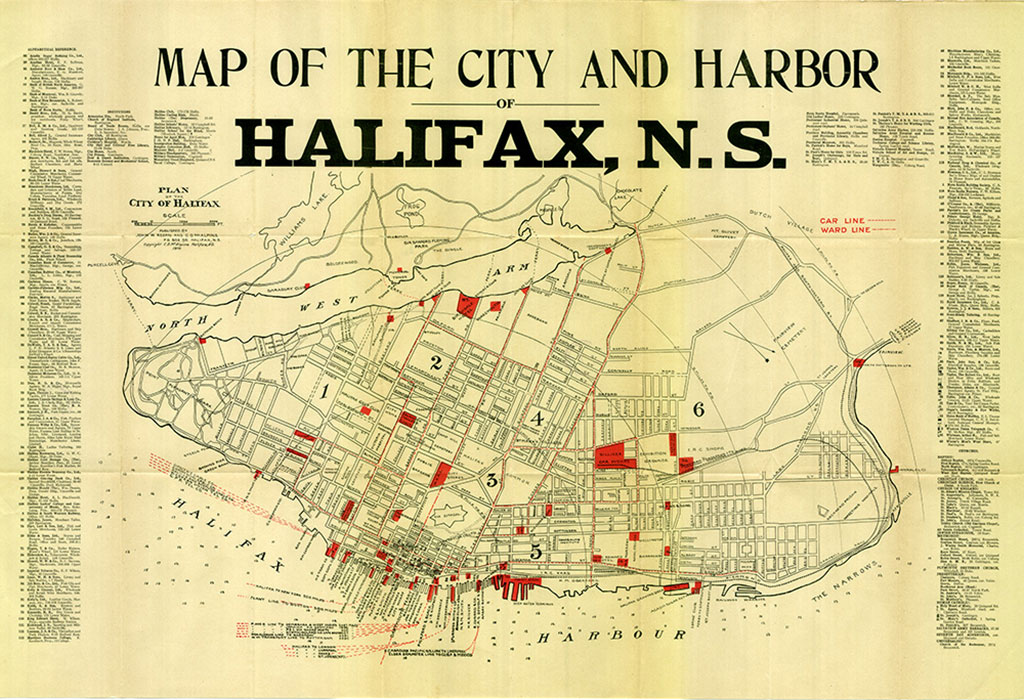
(John W. Regan and C.D. McAlpine, Halifax Municipal Archives 102-5A-26.)
The early arrangements for receiving passengers were rudimentary. Even a decade after the completion of the inland rail link, ocean passengers still usually landed in a cargo shed. The flow of people and baggage in and out of the shed meant that the shed doors were often left open, and in Halifax – mainly a winter port – this was a miserable situation for passengers waiting to be admitted, or to join their trains. Although the small waiting area was none too comfortable, the site did offer immigrants access to washrooms, and baggage and ticketing facilities.[3]
Building a New Immigration Facility at Pier 2
Immigration officials looked to improve the accommodations in 1889.[4] At the time, passengers disembarking at Halifax usually used the Deep Water Terminus, a number of wharves and sheds set up for freight and passenger transit from ship to rail by the Intercolonial Railway. It was at the edge of the North End of Halifax along the waterfront, near the city centre and just down the hill from the Halifax Commons and St. Patrick’s Church. At the Deep Water Terminus, the rails curved away from the rough road running along the waterfront to serve the piers, including Piers 2 and 3. This left a triangle of open ground at the top of the piers, in which immigration authorities cooperated with railway agents to build a 200-foot-long immigration shed. The shed was complemented by an additional small out-building, offering a kitchen, dining rooms, and sleeping accommodations. This new facility for immigration at Pier 2 was completed in the winter of 1890.[5]
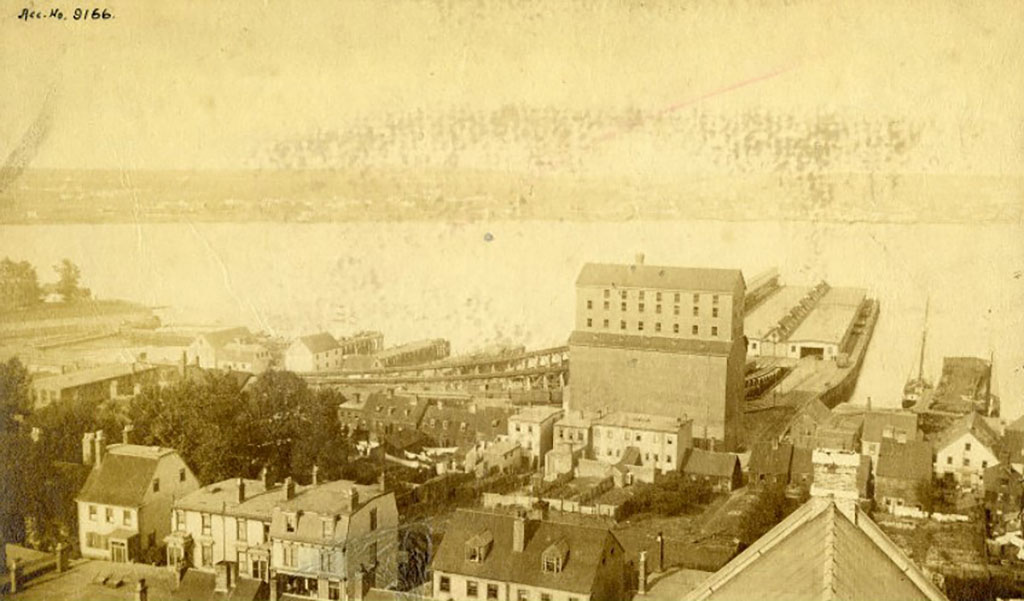
(Notman Studio, Nova Scotia Archives, 1983-310, no. 100026.)
The work to establish proper reception facilities was undone by fire in February 1895. Much of the infrastructure at the Deep Water Terminus burned, including the immigration quarters.[6] In the absence of proper landing facilities, passengers were landed at Cunard’s wharf (just south of Pier 2) and examined at the North End railway station.[7] The Intercolonial Railway moved quickly to rebuild, and had plans in place by the end of the next month.[8] However, the search for replacement accommodation became even more pressing in the spring, as a blaze took the Intercolonial Railway’s Richmond terminal (in the North End of Halifax, near the foot of Richmond Street) in May 1895. Although a bit further from the railway station, the pier and shed at Richmond had been used at times to assist in clearing immigrants after the February fire.
Troubles with the Rebuilt Immigration Quarters
Despite the pressing need for a replacement, it was two full years after the original fire before a new building was ready. In February 1897, the Intercolonial Railway opened new immigration quarters at Pier 2. The new pier was short and angled, making it not suitable for larger passenger liners. Given this shortcoming, steamship companies preferred to land their passengers at Pier 3, next to Pier 2. It was longer and served on one side by a wider basin – the basin shared with Pier 2 was narrow enough that having two ships in at once was the cause of damaging accidents. Although Pier 3 was better for ships, it was not suited for passenger arrival. People who disembarked at Pier 3 had to walk across railway tracks and through busy freight handling areas between the piers to reach the immigration quarters.[9] It was also easy for authorities to lose track of arrivals as Pier 3 was not a secure space in any way – it was merely an open shed. Someone could very easily disembark and simply walk out without being examined.
Besides the pier, the new building had some problems in its own right. Perhaps the chief complaint was the lack of detention quarters for inadmissible passengers.[10] The building was also accessible to the general public, so immigration agents complained that “idlers and loafers” were a nuisance at the site, ranging through the entire facility and peering in the windows. During ship arrivals, the immigration officers complained that “crowds of people surround the building.”[11]
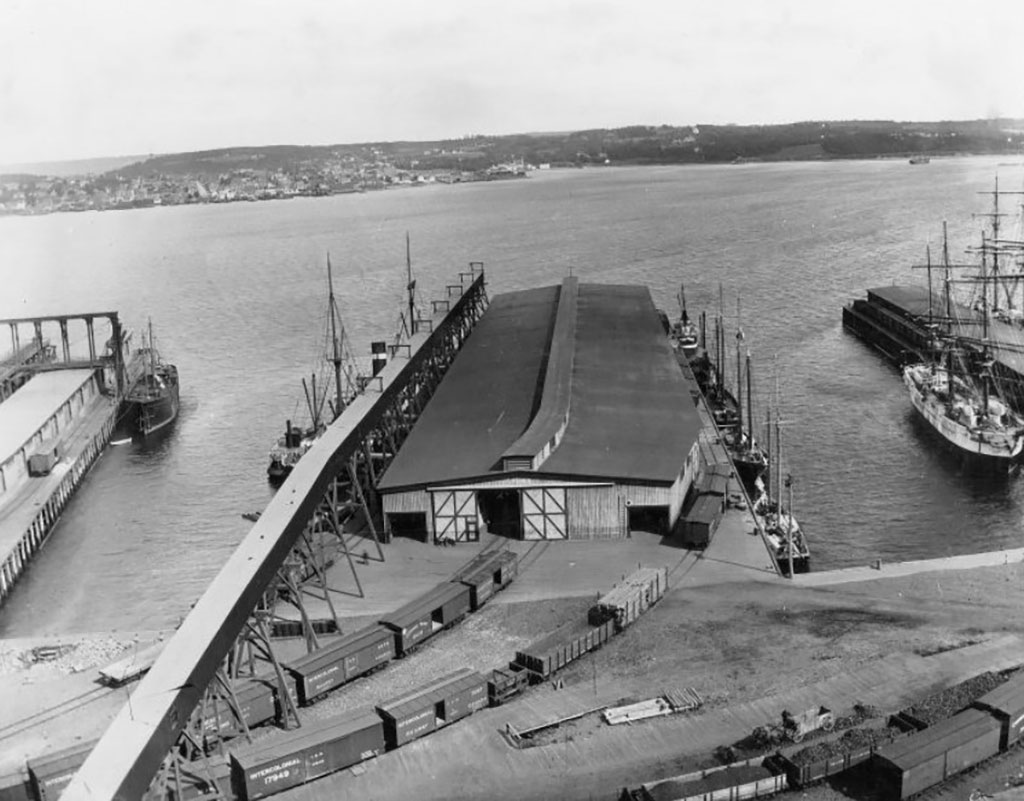
(Notman Studio, Nova Scotia Archives, 1983-310, no. 100030.)
Updating the Immigration Quarters
These deficiencies led to a prompt update of the immigration quarters.[12] In 1905, a second storey was added.[13] The spaces for examining passengers and their baggage moved up to the higher level. This served larger passenger liners well, as they were built to serve gangways at that height. The ground level was updated to serve passengers who had cleared the immigration inspection and were waiting to join their trains inland. It featured ticket agents, a dining room, and space for the passengers to wait.[14]
The renovation made the site much more suitable for immigration, with one ships’ captain having remarked that the 1905 update was “equal to any place he had ever visited.”[15] This was good timing for the port of Halifax, as after 1905 there was a substantial surge in immigration to Canada. While the new building functioned well, the issues with the actual pier and shipping use remained, and so in 1911 the Department of Railways and Canals planned yet another construction project at Pier 2, including a very large pier as well as new sheds and immigration facilities. Unfortunately, the construction ran for several years. Just prior to the First World War, during the peak years of Canadian immigration, the Halifax facilities were in turmoil. By the end of 1913 - a year that saw over four hundred thousand immigrants enter Canada - the new concrete pier was in place, but another two years passed before the new shed and immigration quarters built on that pier were ready for use. The new facility opened in the fall of 1915.[16]
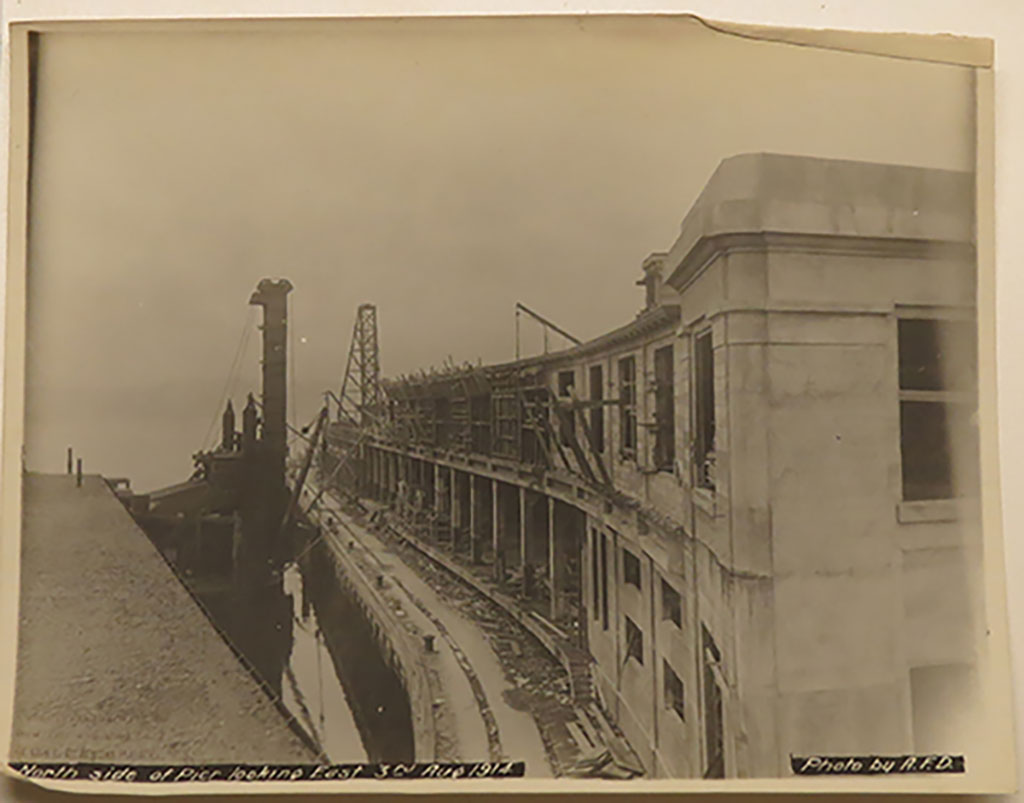
(Library and Archives Canada, Department of Railways and Canals fonds, RG 43, Vol. 451, file 12795.)
The Improved Pier 2 in 1915 and its Function During the First World War
The 1915 building at Pier 2 was a major improvement on prior quarters, and was comparable to the quarters that were eventually developed at Pier 21 in size – but integrated in a single building. It could accommodate two ships at once, and improved passenger safety during the transit from ship to rail by housing sunken tracks inside as well as directly beside the shed. The 1915 quarters also included spaces for many support services, ranging from charities to railway ticketing, telegraph agencies, and US immigration offices.[17]
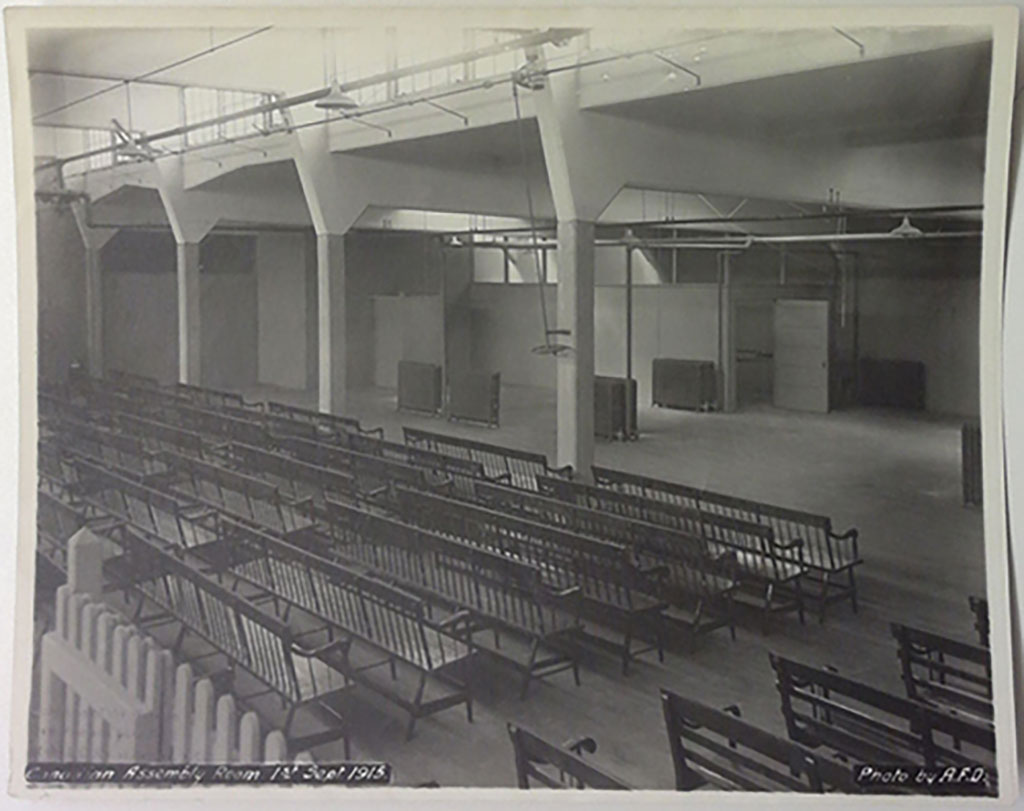
(Library and Archives Canada, Department of Railways and Canals fonds, RG 43, Vol. 451, file 12795.)
Upon opening, the new Pier 2 building was immediately pressed into service as a key embarkation point for Canada’s war effort in the First World War. During the war, it survived the Halifax Explosion, returning to service less than two weeks after the blast.[18] After the war, it was returned to the immigration department for their use and remained a key ocean processing facility until the overnight move from Pier 2 to Pier 21 in March 1928.
Conclusion: A Critical Ocean Gateway
Pier 2 was an important site of entry for many who arrived by sea to Canada during the period of time between the completion of the Halifax Rail Line and the opening of Pier 21. Early facilities were rudimentary, and complicated by factors such as winter weather and lack of detention quarters. Renovations undertaken before the First World War improved the space just in time to accommodate a surge of immigration, and the building became an embarkation point for Canadian service personnel until the War’s end. Immigration operations moved to Pier 21 in 1928.
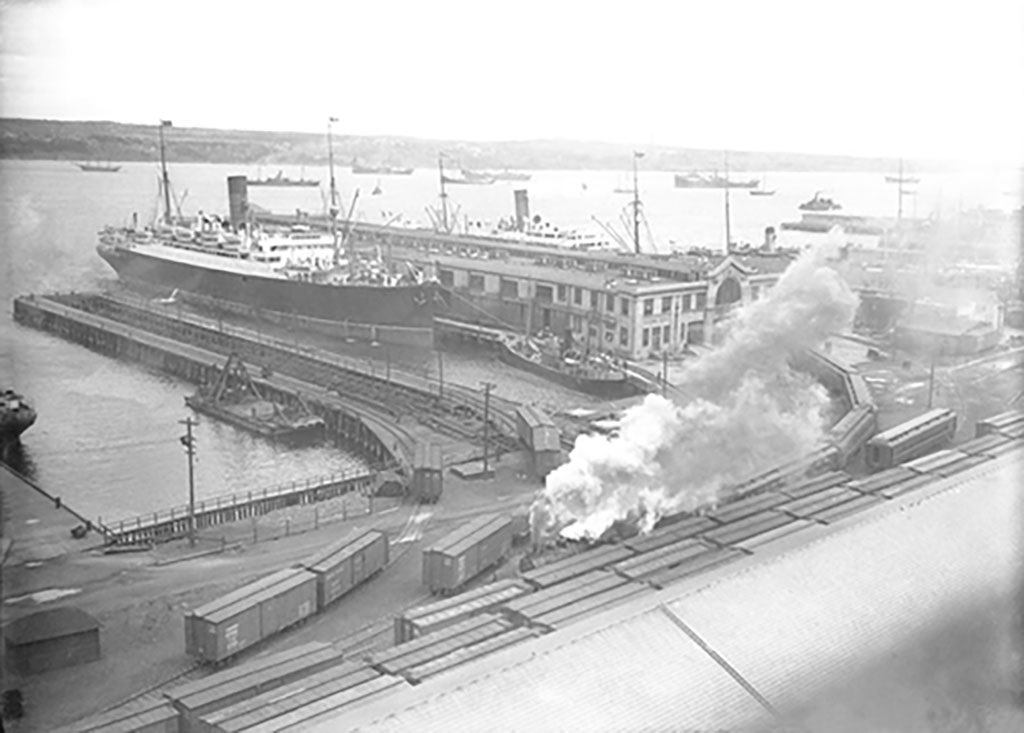
(W.R. MacAskill, Nova Scotia Archives, 1987-453, no. 2625.)
- Sandford Fleming, The Intercolonial: A Historical Sketch (Montreal: Dawson Brothers, 1876), 239.↩
- Lisa Chilton and Yukari Takai, “East Coast, West Coast: Using Government Files to Study Immigration History,” Historie Sociale/Social History 48:96 (May 2015), 12.↩
- D. Owen Carrigan, “The Immigrant Experience in Halifax, 1881-1931,” Canadian Ethnic Studies 20:3 (January 1988), 30.↩
- Library and Archives Canada , Department of Agriculture fonds, RG 17, vol. 610, file 69092, “J.S. Blogdon & Son, Halifax: Estimate for new immigration shed at Halifax; with memo from Mr. Lowe,” Memorandum of John Lowe, Deputy Minister of Agriculture, 23 April 1889. From Confederation until 1892, immigration matters fell under the Department of Agriculture.↩
- LAC, DA fonds, RG 17, vol. 626, file 70944, “Acknowledging letter of 14th instant re erection of new Immigration Shed at Halifax,” Secretary, Department of Public Works, to H.B. Small, Secretary, Department of Argiculture, 7 October 1889; Library and Archives Canada, Department of Agriculture fonds, RG 17, vol. 665, file 75843, “Urging the immediate fitting up of the new Immigration Shed,” E.M. Clay, Halifax Immigration Agent, to John Lowe, 15 November 1890.↩
- File 142, pt. 2. E.M Clay to A.M. Burgess, Deputy Minister of the Interior, 27 February and 12 March 1895. After 1892, responsibility for immigration rested with the Department of the Interior under the Immigration Branch until the Department of Immigration and Colonization was created in 1917.↩
- File 142, pt. 2, E.M. Clay to A.M. Burgess, 4 and 21 March 1895.↩
- File 142, pt. 2, E.M. Clay to L.M. Fortier, Secretary, Department of the Interior, 23 April 1895; and A.M. Burgess to T. Mayne Daly, Superintendent-General of Indian Affairs and Minister of the Interior, 25 April 1895.↩
- File 142, pt. 3, Lyndwode Pereira, Assistant Secretary, Department of the Interior, to H. and A. Allan, agents for Allan Lines, 5 March 1897; “One of the Finest: The New Immigrant Shed at the Terminus,” Halifax Daily Echo, 14 January 1895; File 142, pt. 3, G. Hannah, Montreal agent for Allan Lines, to A.M. Burgess, 23 February 1895; unattributed diagram of proposed addition to immigration wharf at Halifax, May 1898; T.E. Clay, acting Halifax Immigration Agent, to L.M. Fortier, 13 April 1897; and memorandum by W.D. Scott, 3 June 1897.↩
- File 142, pt. 4, L.M. Fortier to J.A. Smart, Deputy Minister, Department of the Interior, 21 October 1902.↩
- File 142, pt. 3, J.A. Kirk, Halifax Immigration Agent, to Clifford Sifton, Minister of the Interior, 20 October 1897.↩
- File 142, pt. 4, J.A. Smart, Deputy Minister of the Interior, to D. Ewart, Chief Architect, Department of Public Works, 9 January 1904; F.W. Annand, Halifax Immigration Agent, to J.A. Smart, 12 April and 2 June 1904; and D. Ewart to J.A. Smart, 7 and 15 April 1904.↩
- File 142, pt. 4, W.D. Scott, Superintendent of Immigration, to J.A. Smart, 7 October 1904; and F.W. Annand to W.D. Scott, 27 November 1904.↩
- “Immigration Building Undergoes Changes,” Halifax Daily Echo, 23 March 1905.↩
- “Sees Big Improvement in Facilities Here,” Halifax Daily Echo, 28 December 1908.↩
- File 12795, A.J. Dyer, Resident Engineer, to John Kennedy, Engineer, 8 December 1911; and to track the progress of construction at Pier 2, see images and correspondence from December 1913, December 1914, and September 1915.↩
- File 142, pt. 6, F.P. Gutelius, General Manager of the Intercolonial Railway, to W.D. Scott, 12 April 1915. Gutelius’ note is interesting in that he communicated his assumptions about capacities to pay and relationships between organizations seeking accommodation at Pier 2. For instance, he commented on US officers claiming the expense of invitations to be in Halifax from the railways, and opined that the Salvation Army, although generally a charity, made “considerable money out of the people that they look after.” See also File 19403, “General Plan of Offices and Baggage Equipment in Upper Storey of Shed No 2,” Plan 882, 4 July 1913.↩
- File 142, pt. 8, W.L. Barnstead, Halifax Immigration Agent, to W.D. Scott, 18 December 1917; and memorandum of T.W. Puller, Assistant Chief Architect, Department of Public Works, 26 December 1919.↩